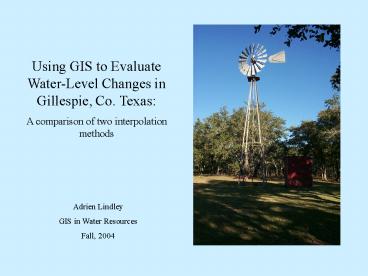Using GIS to Evaluate Water-Level Changes in Gillespie, Co. Texas: - PowerPoint PPT Presentation
Title:
Using GIS to Evaluate Water-Level Changes in Gillespie, Co. Texas:
Description:
Aquifer Coverages. Groundwater Database (dBase format) Well locations. Depth to water ... (LSE), date of water level measurement, aquifer code and state well number. ... – PowerPoint PPT presentation
Number of Views:22
Avg rating:3.0/5.0
Title: Using GIS to Evaluate Water-Level Changes in Gillespie, Co. Texas:
1
Using GIS to Evaluate Water-Level Changes in
Gillespie, Co. Texas A comparison of two
interpolation methods
Adrien Lindley GIS in Water Resources Fall, 2004
2
Outline
- Introduction
- Base map Construction
- Interpolating Piezometric Surfaces
- Raster Calculations
- Results and Conclusions
3
Introduction
- Goals
- Create a base map with water level elevations for
the Hensel sands in Gillespie county. - Create grids depicting the water level elevation
for 3 consecutive years using Inverse Distance
Weighting (IDW) and Spline. - Calculate the change in water table elevations
from year to year. - Evaluate the results.
4
Introduction
- Where is Gillespie County?
5
Gillespie county, a closer view
6
Base Map Construction
- Data Sources
- TWDB
- HUWCD
- TNRIS
- Data Type
- Aquifer Coverages
- Groundwater Database (dBase format)
- Well locations
- Depth to water
- DEMs and Digital Orthophoto Quarter Quads
- TxDOT Gillespie county road coverage
7
Database Management
- Well databases included well location, depth of
water from land surface elevation, land surface
elevation (LSE), date of water level measurement,
aquifer code and state well number. - Sorted well data by date of water level measure
in Excel. - Selected out all the July water level
measurements for each year. - Resorted each database table for the Hensel
aquifer. Using the aquifer codes. - Created new database tables for for the years
2001, 2002 and 2003.
8
Initial base map with all wells
9
Base map with sorted wells
10
Interpolating Water Level Data
- Spatial analyst
- Set extent of analysis to be the same as the data
extent - Interpolate to raster water level elevations
using IDW and Spline for the 3 years of data - Make permanent the resulting grids
11
Spatial extent for analysis
12
Water level elevations for July, 2001 using IDW
- Elevation in feet
13
Water level elevations for July, 2002 using IDW
- Elevation in feet
14
Water level elevations for July, 2003 using IDW
- Elevation in feet
15
Water level elevations for July, 2001 using
Spline
- Elevation in feet
16
Water level elevations for July, 2002 using
Spline
- Elevation in feet
17
Water level elevations for July, 2003 using
Spline
- Elevation in feet
18
Using Raster Calculator
- Water level elevation grids are subtracted to
yield yearly water level change
-
19
ResultsCalculations for Yearly Difference
20
Water level change from 2001 to 2002 from IDW
grids
- Brown indicates an area where the water table has
lowered
Elevations in feet
Mean water level change - 1.07 feet
21
Water level change from 2002 to 2003 from IDW
grids
- Brown indicates an area where the water table has
lowered
Elevations in feet
Mean water level change 3.19 feet
22
Water level change from 2001 to 2003 from IDW
grids
- Brown indicates an area where the water table has
lowered
Elevations in feet
Mean water level change 2.12 feet
23
Water level change from 2001 to 2002 from Spline
grids
- Brown indicates an area where the water table has
lowered
Elevations in feet
Mean water level change - 2.01 feet
24
Water level change from 2002 to 2003 from Spline
grids
- Brown indicates an area where the water table has
lowered
Elevations in feet
Mean water level change - 4.09 feet
25
Water level change from 2001 to 2003 from Spline
grids
- Brown indicates an area where the water table has
lowered
Elevations in feet
Mean water level change - 6.10 feet
26
Comparison of raster calculation results
- Similar values for 2001 to 2002
- Difference in water table elevations of 7.28 feet
for 2002 2003. - Which method is more accurate?
27
IDW or Spline?
- IDW
- Chunky display, obviously not representative of
natural conditions
- Spline
- Smoother display, probably more representative of
natural conditions
28
Conclusions
- Limited well control across the area for a
specific time and aquifer yields questionable
results
29
Acknowledgments
- Special thanks to Paul Tybor and Margaret Ratliff
of the Hill Country Underground Water
Conservation District
30
Thanks































